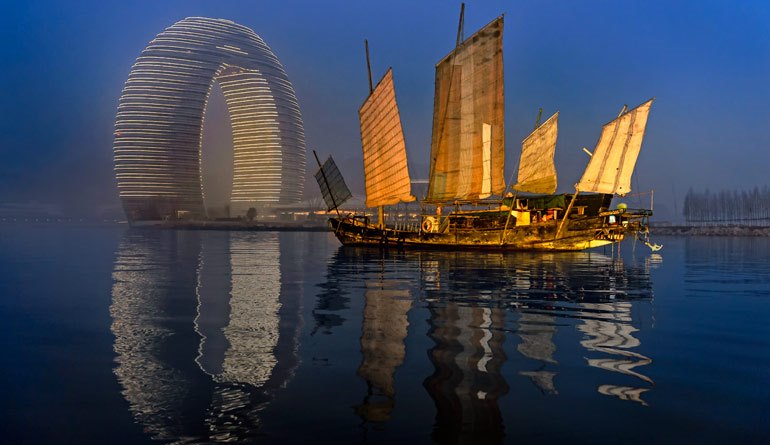Imagine what our cities would look like if we did not drain the rainwater away through pipes and pumps, but instead used the ancient wisdom of peasantry in field-making to create a green sponge in the city that retains the rain water, creating diverse habitats and recharging the aquifer.

Before & After: “Green Sponge” for a Water-Resilient City, Qunli Stormwater Park in Harbin City, Heilongjiang Province, China.
In this way, the green spaces in the city become an ecological infrastructure that provides multiple ecosystem services that regulate the urban environment to be resilient to flood or drought, allowing clean water and food to be produced right in the middle of the city.
Biodiversity would be enhanced dramatically; urban residents would have a green network for jogging, commuting, and relaxing; and real estate values would increase because of the beauty of, and access to, nature! That is what we have tried to do in many cities in the past twenty years: to transform the city into a “sponge city”.
 Imagine what our cities would look like if we abandon the high and rigid concrete flood walls and instead revive the ancient wisdom of peasantry and create vegetated terraces at the river banks that adapt to the up and down of the water flow.
Imagine what our cities would look like if we abandon the high and rigid concrete flood walls and instead revive the ancient wisdom of peasantry and create vegetated terraces at the river banks that adapt to the up and down of the water flow.
Ecofriendly solutions like ponds and low weirs are designed to slow down the flow of water and let nature take time to nourish itself, so that diverse habitats can be created that enrich vegetation and wild life, allowing nutrients to be absorbed by the biological processes! That is what we have done to transform the mother rivers in many Chinese cities.
Imagine what our cities would look like if the nutrient-rich (eutrophic) river and lake water could be cleansed through the landscape as a living system, in the way that peasants have recycled organic waste, instead of using expensive sewage plants to remove the nutrients.
We could produce clean water and nourish the lush vegetation. Native biodiversity could be improved. We could turn recreational spaces into urban parks and, in this way, urban parks could become producers instead of consumers of energy and water. That is what we have done to transform the landscape into a living system that mediates polluted water.
Imagine what our cities would look like if the brownfields of industrial sites are recovered by the processes of nature, where the ancient wisdom of the pond-and-dyke system is adapted to create a terrain that collects rainwater (instead of draining it away through pipes) and initiates the evolution of a plant community, remediating the contaminated soil during this process.
At the same time, the industrial structures are preserved as sites of cultural heritage in the city. A unique landscape is created, featuring dynamic native vegetation and a touchable memory of the past, which attract urban residents because of its beauty as well as the diverse wild life that it maintains in the middle of the city. This is what we have done in several industrial cities.
By reviving the ancient wisdom of field making, irrigating, fertilizing, growing, and harvesting, and integrating this wisdom with the contemporary sciences and arts, we are able to build alternative infrastructures – nature-based green infrastructures replacing the conventional gray infrastructures – that are able to solve some of the problems in today’s urban environment, particularly around water, which are difficult or very expensive to solve through conventional means. Living with nature is inexpensive and easy, comfortable and beautiful, and an art of survival.
About the Author
Kongjian Yu is Founder and Dean of the College of Architecture and Landscape and Cheung Kong Scholar Chair Professor at Peking University, and Founder and President of Turenscape. He was elected a member of the American Academy in 2016.
Featured photo courtesy of the Sheraton Huzhou Hot Spring Resort in Huzhou China.



